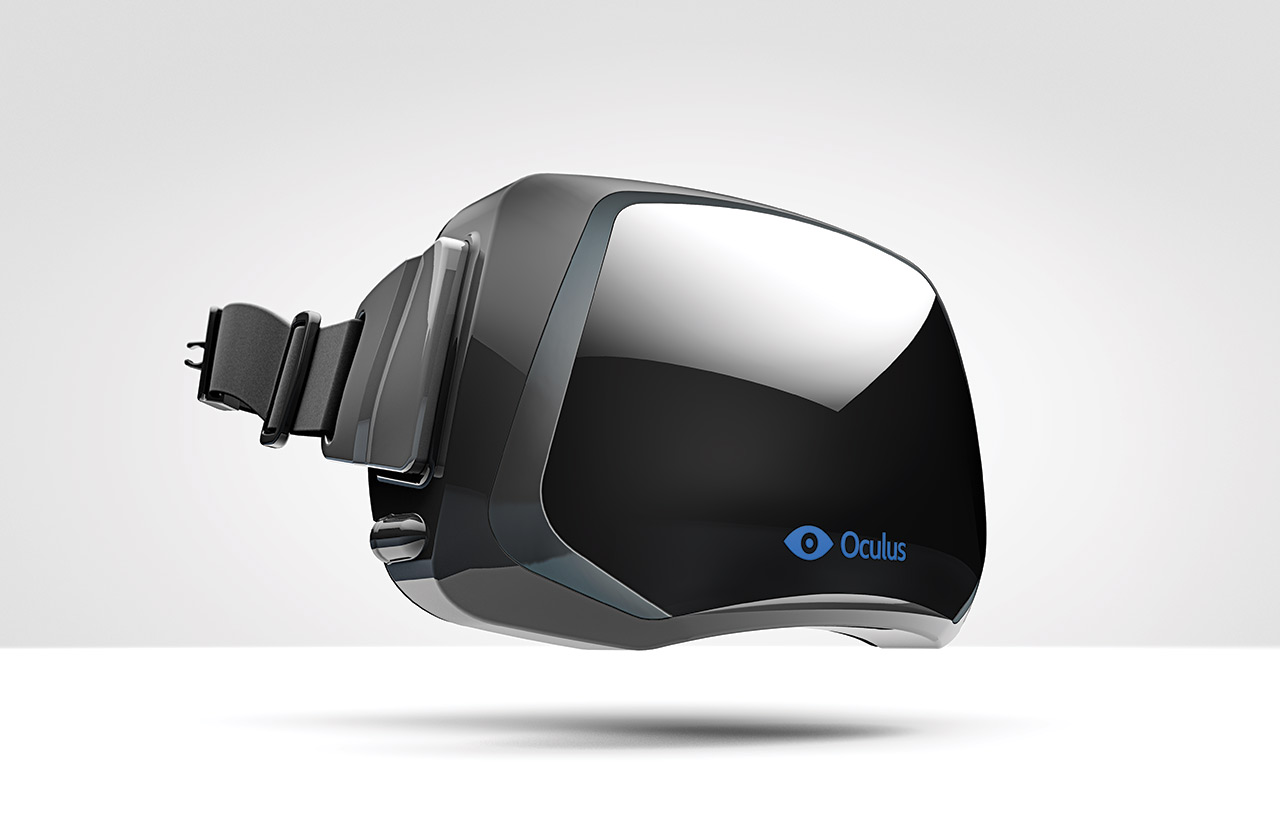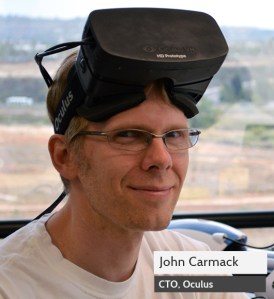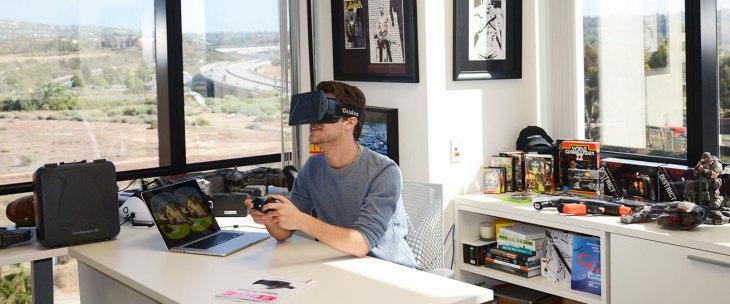A company that was conceived just over a year ago announced its Series B round of funding late last night, with a massive raise of $75 million to add to its existing $16 million Series A and $2.4 million in Kickstarter crowdfunding dollars. That company is Oculus Rift: A virtual reality headset dreamt up by Gaikai veteran Brendan Iribe and a team of other startup vets. With nearly $100 million invested, expectations are huge, but the company is ready to meet those expectations, Iribe tells TechCrunch, and exceed them with a vision of the future that blurs the line between the virtual and the real.
Why So Much Money, So Fast
The Rift has already managed to sell over 42,000 units prior to its consumer launch, via development kits that are admittedly rough around the edges, according to Iribe. That’s impressive enough, but it’s not what’s selling investors like Marc Andreessen and game industry legends like John Carmack on the Rift – that’s the experience provided by the next-generation prototype, which is functionally the same as what we’ll see from the first consumer device, Iribe says, but which has been used by only a few hundred people at most as of right now.
Once the new prototype was perfected, Iribe got in touch with Marc Andreessen and Chris Dixon, to say that they’d achieved what they’d set out to do and asked how soon they could come in to see it. The combination of the prototype demonstration, and former id founder and Doom creator John Carmack explaining his vision of where he sees the entire Oculus project headed “pretty much convinced them on the spot,” Iribe tells me. Dixon and Andreessen join the fairly limited group of outside VCs with ownership stake in Oculus VR, and Iribe says that the partners and funding were chosen specifically with the intent that they should help them get to through the initial V1 consumer launch without having to go find more money elsewhere.
“The point of the first raise was to build out the technology,” Iribe says, explaining what the money has been spent on so far. “We actually thought it would take us a bit longer to get to the point of where we’re at now.”
But it didn’t take that long. The new Oculus Rift prototype should be virtually identical in terms of experience to the version that ships to consumers.
Achievement Unlocked: Consumer-Caliber Experience
“We got to the point where the latest prototype of this technology really is beyond even what we expected for V1,” Iribe told me. “We kind of put the hammer down and said ‘Okay, this is it, this is definitely enough to totally blow away the world and deliver our consumer, V1 product.’ We’re looking back even now on the dev kit and going ‘oh gosh, this new one is so much better.’ It is literally an entirely different experience.'”
 “Of the 300 people who have seen the current prototype, not a single person has come away not saying ‘That’s gonna change the world,’ and that’s really [what we needed to accomplish] in terms of delivering on the promise of the vision we’ve all had for so many years,” Iribe says.
“Of the 300 people who have seen the current prototype, not a single person has come away not saying ‘That’s gonna change the world,’ and that’s really [what we needed to accomplish] in terms of delivering on the promise of the vision we’ve all had for so many years,” Iribe says.
There’s a general feeling that it’s a true ‘Holy Grail’ experience in terms of immersive reality tech among those who’ve tried the latest prototype, Iribe says. I asked if I’d be able to see for myself at CES coming up in January, but he says they’re not ready to announce yet what they’re bringing to the show, and we’ll find out closer to the date. Not to read too much into it, but that does sound pretty promising for those hoping to get a sense of this new design in action. The latest hardware still isn’t close to final in terms of product design, however, Iribe adds:
“It’s what we want to bring as an experience,” he said. “It’s a prototype, so it still has its circuit boards and exposed wires and all that, but the experience, meaning once you put the device on, it is what we want to deliver in a consumer product. People go in, spend long periods of time in the experience and come out and say ‘I want to do more of that.’ There’s no kind of discomfort, no dizziness, no nausea. So many of the technical hurdles have been pretty much nailed.”
Vision In The Near-Term: Both Literal And Figurative
As for things they’re still working on the engineering side, Iribe says that there’s an increasing interest in building more advanced eye movement detection to the Rift’s functionality.
“[We recently hired] a lot of vision guys, that’s a big effort for us now,” he says. “We’re really focusing on the vision side, in terms of tracking and using optical tracking and camera tracking. That’s going to be a big focus for us going forward. Over time, we want to get more of the body in the game, but right now we’re trying to get your eyes in the game, combining your vision with your head tracking.”
Aside from engineering work, there’s a lot that needs to be nailed down in the immediate future. There’s figuring out how to consumerize the actual product design itself, and then ramping up the initial production run. That’s why Iribe isn’t putting a firm date on the Rift’s availability date just yet: internally, they have a pretty good idea of when to expect it to reach retailers and customers, but they’re purposely keeping tight-lipped about those projections to make sure everything’s ready when the time comes. To that end, they’re also hiring smart people aggressively in virtually every capacity, as there’s not just a hardware and software component to the Rift, but services, an ecosystem, a consumer education initiative and much, much more that all need to come together at launch.
Carmack Codes And Codes And Codes To Avoid A Deflating Launch
Hardware startups, especially those dealing with novel input paradigms or wearable computing, have been multiplying sharply in the past couple of years, and recently we’ve seen a number that were initially crowdfunded via pre-orders deliver their shipping consumer devices. The results aren’t pretty: while some like the Pebble have been fairly well-received (though not universally loved), others like the Leap Motion and the Ouya have sounded a sour note. Iribe admits that potential fate is a little daunting, but believes that Oculus is doing everything right to avoid the same kind of crash at the gate.
 “John Carmack is writing code as fast as he can, travelling as little as he can,” he said. “I think he’s back to the early days of kind of a Doom and Quake era of him being held up in a room just programming as fast as he can to make this work really well, and he tells me having more fun than he’s had in a really long time.”
“John Carmack is writing code as fast as he can, travelling as little as he can,” he said. “I think he’s back to the early days of kind of a Doom and Quake era of him being held up in a room just programming as fast as he can to make this work really well, and he tells me having more fun than he’s had in a really long time.”
That likely explains why his dual roles at both Oculus and id didn’t last long, as he stepped down from the original home of Doom and Quake late last month to focus on being Oculus VR’s CTO full-time. Carmack is doing what he loves most at Oculus, according to Iribe, which is tackling a difficult problem that’s “right on the edge of reality.” Carmack pioneered both 2D and 3D gaming, and he’s doing the same thing all over again with the Oculus Rift, and it “really works,” Iribe says.
Acquisition Potential, Valuation And Launch Sales Estimates
Along with launch date and Carmack project specifics, Oculus is also keeping mum on valuation. Essentially, Iribe very loosely suggested a 20 to 40 percent equity sale at this stage for a startup like Oculus VR, which would put the valuation somewhere between $200 and $400 million or so, with the heavy caveat that this is mostly educated guessing on my part and not data sourced direct from the company.
“The valuation wasn’t so high that [our investors] were getting a tiny sliver, we had a pretty good valuation at each round […] that was fair for everybody,” was the only thing Iribe would say for sure on the matter. “It’s good, but not too crazy.”
That valuation is high enough that any prospects of Oculus Rift getting scooped up by Microsoft, Sony or any other major incumbent gaming company is slim to none, Iribe says, at least until after they deliver their initial run of consumer devices. He also says that personally, the idea of having built what they have and not releasing it themselves just seems impossible.
“We feel like we have a pretty good idea of what we can sell through pre-orders, and through consumer launch, for the first six, eight or even twelve months,” Iribe explains regarding their budgeting and the amount raised, and why they don’t anticipate having to find more capital pre-launch. Extrapolating from comments he made to me, I’d suggest they’re looking somewhere in the neighborhood of one million devices for a production run funded by what’s in their existing coffers, though Iribe declined to get into specifics. He did say that they see that expanding to hundreds of millions of devices and active users sometime in the next decade or so, thanks to the long-term Oculus vision of VR beyond the confines of gaming.
Immersed In The Big Picture
What we’re looking at is the evolution of virtual reality, starting with this headset. It’s going to be a little bigger than we’d all want it to be of course, and it will have its form factor challenges, but the experience inside is good enough that people are going to really enjoy it, and love going in, playing games and watching movies. And then it’ll quickly evolve, and its form factor will keep getting better; closer and closer to sunglasses, lighter and easier to wear. Very quickly, over the next decade or two, what we’re looking at really becomes about communications.
Just like the smartphone now represents the primary means with which we communicate digitally, Iribe sees a future where VR supplants a lot of the same usage, so that you have a pair of sunglass-style Rift goggles that you simply slip on when you want to talk face-to-face, as if in person, with your friend halfway around the world. Our kids will laugh at stories of typing away on virtual keyboards and smiling back at grainy video into the unblinking eye of a monitor-mounted webcam, and remote business won’t be so remote anymore. In short, Oculus is taking the first step towards a world where the “virtual” in virtual reality is just a technical distinction, not a description of experience.
